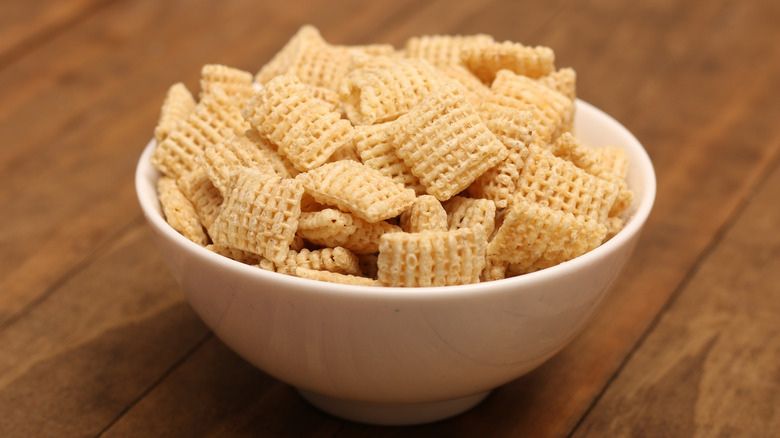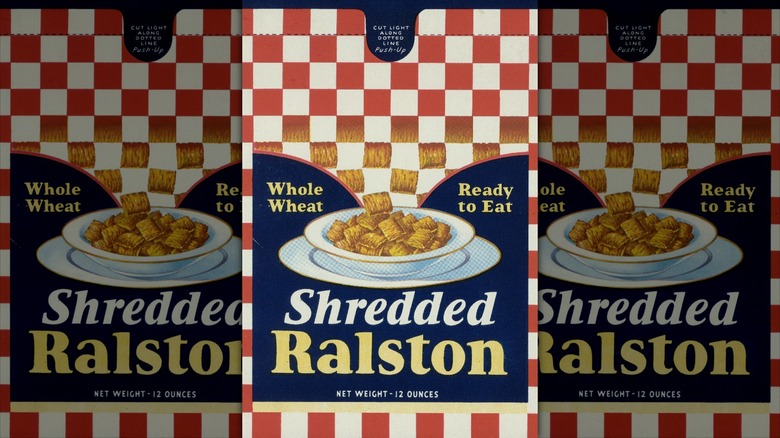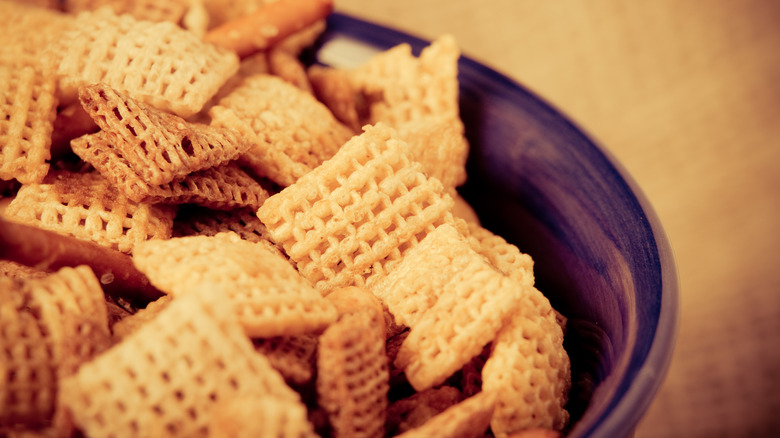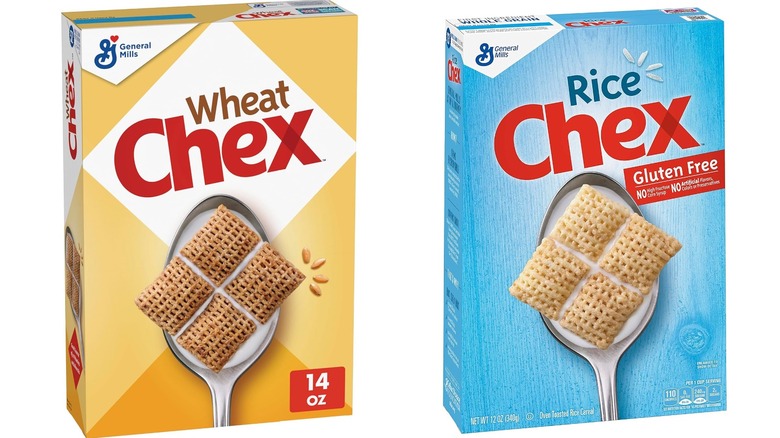The Original Chex Box Is So Unrecognizable, It Features A Different Name
We may receive a commission on purchases made from links.
Originally produced by the Ralston Purina Company, Chex cereals may have cemented their place in the American psyche in the 1950s when Chex Mix was first created. However, their roots stretch back even further. The first Ralston cereal, which was made from cracked wheat, came out in 1898. The earliest precursor of the Chex family, however, is generally held to be Shredded Ralston, a product introduced in 1936.
While Shredded Ralston touted its "new form" in a 1930s advertisement, it was a far cry from the Chex cereals of today — or even of the 1950s, for that matter. Instead of looking as if it belongs in a snack mix, it resembles nothing more than bite-sized shredded wheat.
In fact, if you examine the cereal pictured on the package, you'll find it to be a dead ringer for Frosted Mini Wheats minus the frosting. So why, then, is Shredded Ralston not considered the precursor to that far more similar cereal? The main reason may be that Mini Wheats are a Kellogg's product instead of a Ralston one. What's more, that Johnny-Come-Lately cereal didn't come along until 1969. By that time, the Chex brand was already well established.
Ralston Purina's founder had a thing for checkerboards
Even though Shredded Ralston didn't bear the checkered form adopted by later iterations of the cereal, nor did it have any version of "Chex" in its name, the design of the box may be seen as foreshadowing of some sort. In addition to the name and an image of the cereal, fully half of the packaging is covered in a red and white checkerboard design. What is the importance of this? To Ralston-Purina founder William H. Danforth, this pattern had a special significance.
A representative for General Mills, which now owns Chex, told Mashed that Danforth's boyhood memories included a family (not his own) whose mom used to make all of her kids' clothing out of the same kind of cloth. One year, the pattern was red and white checks, and this distinctive design made an impression on the future cereal tycoon.
He found it so memorable that in later years he chose to adopt it as his company's logo. In 1903, the Ralston-Purina checkerboard got a shout-out in a full-page ad in the literary magazine "Smart Set." The pattern is no longer featured on boxes of Chex, but you can still see a small checkerboard next to the "P" in Purina on every package of that brand's pet food.
Chex cereals and snacks debuted in the '50s
Ralston cereals continued to evolve throughout the first half of the 20th century. As General Mills' representative tells it, two years after Shredded Ralston was introduced, the brand came out with a flaked rice cereal. At some time in the 1940s, the rice cereal was given the name of Shredded Rice, but further changes were in store. 1951 was the official birth year of Chex cereals as we now know them. The first cereal to be re-shaped and re-branded was Shredded Rice, which turned into Rice Chex. The following year, Shredded Ralston underwent similar changes as it morphed into Wheat Chex.
These two types of cereal were the first and only ones to be included in Chex Mix, or Party Mix as it was then known. The company printed recipes for the stuff on boxes and in advertisements as early as 1952. The mixture at the time consisted of these cereals combined with nuts, butter, Worcestershire sauce, and seasonings. By 1958, however, there was a third variant to be added to the mix: Corn Chex, which had just joined the lineup.
These days, even "old-fashioned" Chex Mix recipes tend to call for all three cereals and an even more modern ingredient: bagel chips, a product that wasn't widely available before the 1980s. (Of course, it's easy enough to make homemade bagel chips, so we can't rule out the possibility of some ahead-of-the-curve cook adding this ingredient at an earlier date.)
The packaging continued to evolve through the decades
One old advertisement dating from the early '50s shows nearly identical boxes of Rice and Wheat Chex, but the Wheat Chex box bears the alternate name Shredded Ralston up in the corner while Rice Chex has that spot occupied by a banner announcing "New! Ralston Cereal." Later in the decade, the cereal boxes featured characters from the brand-sponsored TV show "Space Patrol." By the time Corn Chex came around, a more realistic yet still colorful type of packaging was adopted, with the box picturing a bowl of cereal along with an ear of corn.
In the '60s, Chex cereals featured a mascot called Checkerboard Scarecrow, while the '70s saw a short-lived cereal called Sugar Chex with Casper the Friendly Ghost on the box. In the '80s, Chex boxes began featuring characters from the "Peanuts" comic strip.
Over the past 50 years, there's been a move toward more standardization with boxes featuring what a company representative describes as "clear graphics and bright colors." As they explain, these boxes "make ... the cereal easier to market under one brand name and more recognizable." These days, Chex boxes are quite plain, with the emphasis being on what's inside. The packaging colors range from dark brown for chocolate to beige for peanut butter to purplish-red for maple-brown sugar, while blue (of course) stands for blueberry. No need for flashy packaging, after all, when the product itself now comes in so many different varieties.



